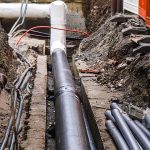Beyond the Trench: Unexpected Applications of Vacuum Excavation Technology
Vacuum excavation, traditionally associated with trenching and excavation for utility installation and repair, is gaining popularity due to its versatility and precision. Clarence Valley Septics, a provider of liquid waste management solutions, recognises the importance of this technology and its diverse applications. This article explores the innovative ways vacuum excavation services are being utilised beyond traditional trenching, highlighting its role in complimenting various industries across Australia. From delicate archaeological digs to hazardous spill clean-ups, vacuum excavation is proving to be an invaluable tool.
Potholing for Utility Location: Minimising Disruption and Maximising Safety
One of the most significant applications of vacuum excavation services is potholing for utility location. Before any excavation work begins, it’s crucial to identify the location of existing underground utilities such as gas pipes, water mains, and fibre optic cables. Traditional methods, like digging with a shovel or backhoe, carry a high risk of damaging these vital services, leading to costly repairs, service disruptions, and potentially dangerous situations. Vacuum excavation offers a safer and more precise alternative. By using a powerful vacuum to remove soil and debris, operators can expose underground utilities without risking damage. This minimises disruption to surrounding areas and ensures the safety of workers and the public, and it also reduces the need for extensive and disruptive excavation work.
Hazardous Spill Clean-up: A Safe and Efficient Solution
Vacuum excavation plays a critical role in the safe and efficient clean-up of hazardous spills. Whether it’s a chemical spill or a release of contaminated material, containing and removing the substance quickly and effectively is paramount. Vacuum excavation services offer a controlled and efficient method for this process. The powerful suction can remove contaminated soil, liquids, and debris, minimising the risk of further spread and exposure. This is especially crucial in environmentally sensitive or hard-to-access locations. The collected material can then be safely transported and disposed of according to regulations, ensuring minimal environmental impact. This capability makes vacuum excavation a crucial tool for emergency response teams and environmental remediation companies.
Debris Removal from Confined Spaces: Accessing the Inaccessible
Another unexpected application of vacuum excavation is the removal of debris from confined spaces. These spaces, such as tanks, pits, and tunnels, can be difficult and dangerous to access using traditional methods. Vacuum excavation offers a solution by allowing operators to remove debris remotely. The powerful suction can reach into these confined spaces, removing accumulated materials without the need for personnel to enter. This significantly reduces the risk of accidents and injuries associated with working in confined spaces. From cleaning out industrial tanks to removing silt from drains, vacuum excavation provides a safe and efficient way to maintain and clean these challenging areas.
Assisting with Archaeological Digs: Preserving History with Precision
Vacuum excavation is even being employed in archaeological digs, showcasing its versatility and precision. Archaeologists often need to remove layers of soil carefully to uncover delicate artefacts and structures. Traditional excavation methods can be too disruptive and risk damaging these fragile finds. Vacuum excavation services offer a gentle and controlled way to remove soil, allowing archaeologists to expose artefacts without the risk of damage. The precision of the vacuum allows for meticulous work, ensuring that even the smallest and most delicate items are preserved. This application highlights the adaptability of vacuum excavation and its potential to contribute to fields beyond construction and waste management.
Updates in Vacuum Excavation Technology
The field of vacuum excavation is constantly evolving, with ongoing advancements in technology and techniques. Manufacturers are developing more powerful and efficient vacuum systems, capable of handling a wider range of materials. Furthermore, there is a growing focus on safety, with new safety protocols and training programs being implemented to ensure the well-being of workers and the public. The Australian government, through its various agencies, emphasises the importance of safe work practices in excavation, including the use of appropriate techniques for utility location. Information on best practices can often be found on government websites dedicated to workplace health and safety.
In Conclusion
Vacuum excavation has clearly moved beyond its traditional role in trenching and excavation. Its versatility and precision have opened up a range of new and innovative applications, from potholing for utility location to assisting with archaeological digs. Clarence Valley Septics recognises the potential of this technology and is committed to providing high-quality vacuum excavation services to meet the diverse needs of our clients. Further advancements in technology promise even more unexpected and beneficial uses for vacuum excavation in the years to come.
Contact Us for Vacuum Excavation Services
Are you looking for a safe, efficient, and versatile solution for your excavation needs? Contact Clarence Valley Septics today on +61 2 6645 3100 or send us a message via our website to learn more about our vacuum excavation services and how we can assist you with your project. Whether you’re planning a construction project, need to clean up a hazardous spill, or require assistance with any other excavation task, our team of experienced professionals is ready to help you.


